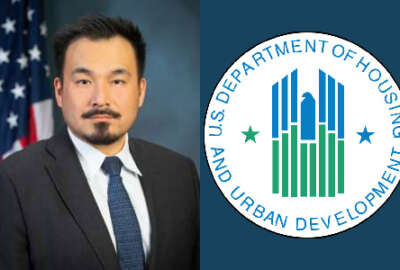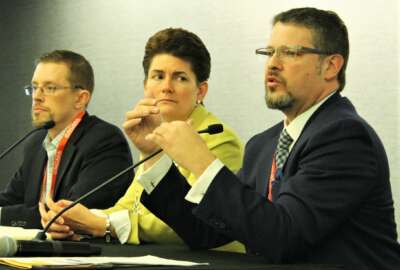

ACT-IAC released a new case study highlighting best practices and lessons learned for agencies as they implement the technologies under the Enterprise...
Well, the Department of Housing and Urban Development finally took the plunge. More than a year after it began to think about phase 2 of the Centers of Excellence IT Modernization initiative, HUD made two awards—one to improve customer experience services and one to accelerate cloud adoption.
“[T]he customer experience CoE will result in improved service delivery for our public housing agencies, grantees and other stakeholders,” said HUD CFO Irv Dennis in a statement.
David Chow, the HUD chief information officer, said in a statement that the cloud adoption CoE will help the agency continue to transform its business processes.
“We are looking to deploy a number of proofs of concept leveraging artificial intelligence, forms-as-a-service and records management,” he said.
HUD’s move into phase 2 of the CoE was a long time coming. It entered the discovery phase in September 2018 and released requests for information in May 2019 for the implementation phase.
The agency becomes the second CoE partner with the General Services Administration to enter phase 2 of this two-and-a-half year old initiative.
The Agriculture Department was the first agency to test out the CoE concept, which brings in technology and business process reengineering experts from GSA’s Technology Transformation Service to guide and train agency executives through the processes.
Under phase 2, HUD and GSA awarded contracts to Booz Allen Hamilton for customer experience and Systems Engineering Solutions Corp. for cloud adoption.
Four more awards for contact center help and three for data analytics support services could be on the horizon as HUD and GSA issued three requests for quotes in September and a total of six RFQs by October.
Through the customer service contract, Booz Allen will build a centralized customer experience capability under a new Office of Customer Experience.
The RFQ stated the contractor will “provide HUD with the ability to have a clear shared vision of how to serve its customers, coordinate and streamline operations, develop comprehensive standards for measuring CX, reduce cost through centralized planning, identify customer issues early and before they become widespread, improve employee retention and recruitment, implement changes in how services are delivered to measurably improve customer and citizen experiences and satisfaction and foster a customer-focused culture at HUD via CX activities and training.”
Under the cloud adoption CoE, Systems Engineering Solutions Corp. will focus on modernizing HUD’s electronic records management processes so it can stop accepting millions of paper forms, which require manual data entry and makes data gathering much more difficult.
“The contractor must implement an ERM capability and develop an open application programming interface (API) that allows for modularized integrations with existing and custom-based services,” HUD and GSA state in the RFQ. “Rollout of the ERM capability will target individual program areas, leading up to enterprisewide adoption.”
GSA didn’t say how much each of these contracts are worth.
While it’s good news for HUD to finally move to phase 2, it took way too long given the agency recognized the need for IT modernization nearly two years ago. The CoE process must move faster to truly have its intended effect.
While the coronavirus pandemic brought a short term focus on IT modernization, many agencies still must take the long view.
This is obvious in Sen. Maggie Hassan’s (D-N.H.) letters to 10 agencies asking for their IT modernization strategies and priorities.
That long-term vision also is part of a network and telecommunications modernization effort under the Enterprise Infrastructure Solutions (EIS) program run by the General Services Administration.
A new white paper from ACT-IAC, which partnered with GSA, the Office of Management and Budget and other federal executives, highlights success factors and lessons learned from several first-mover agencies.
“Certain agencies are ahead of others and are more mature with some of their processes so if you can look at what those leaders are doing, there is a lot we all can learn from those leading organizations,” said Dave Powner, the director of strategic engagement partnerships at MITRE, the former director of IT management issues at the Government Accountability Office and who led the working group developing case studies on several topics including IT modernization and EIS for the ACT-IAC Institute for Innovation. “One of the things that surprised me was despite a lot of negative tone with EIS deadlines having slipped their dates, there are some good news stories buried within the EIS contract vehicle, especially with how large the awards have been.”
The case study detailed four common themes among the agencies who already made awards under EIS, including the departments of Interior, Justice and Veterans Affairs as well as NASA and the Social Security Administration.
While nothing surprising emerged from the case study—things like partnering with industry, planning for IT modernization and taking advantage of EIS’s emerging technologies are typical lessons learned for any project—the one area that did jump out was around modernization.
GSA told the working group that of the 109 solicitations that have completed the scope review, 79 included the move or expansion of Ethernet or voice over IP (VOIP) and 27 included software-defined wide area network (SD-WAN) capabilities.
“Key modernization trends agencies are employing include data center consolidation, managed network services, managed unified communications, Ethernet services, network consolidation and SD-WAN,” the case study stated. “Although SD-WAN is not a defined service offering on EIS at this point, agencies are taking advantage of existing flexible service offerings to include SD-WAN in their solicitations. Agencies are exploring the zero trust security and micro-segmentation models made possible through TIC 3.0 and under EIS.”
The one thing the case study doesn’t address is how to get agencies moving faster with releasing and awarding fair opportunity solicitations.
Powner said one approach would be to add EIS progress to the Federal IT Acquisition Reform Act (FITARA) scorecard.
“Congress and GAO could give grades as a way to move it along more quickly,” he said. “While some folks focus on who got the ‘Ds’ and ‘Fs,’ but I like to focus on the ‘As’ and ‘Bs’ and asking why are those agencies successful? We could view EIS in that light also.”
Powner said several other case studies are in the works and could be completed by the end of the calendar year. He said white papers around Technology Business Management standards and agencies’ use of working capital funds already started, while others such as one on the acquisition periodic table, acquisition innovation, the Centers of Excellence initiatives and the Labor Department’s use of IT metrics are among the others in the planning stages.
Copyright © 2025 Federal News Network. All rights reserved. This website is not intended for users located within the European Economic Area.
Jason Miller is executive editor of Federal News Network and directs news coverage on the people, policy and programs of the federal government.
Follow @jmillerWFED



